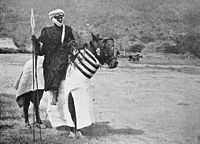Mourâhiline
موراهيلين | |
|---|---|
 A Mourâhil family in Mabifia | |
| Total population | |
| 600,000 (2019, est.) | |
| Regions with significant populations | |
| Languages | |
| Mourâhili Badawiyan | |
| Religion | |
| Irfan | |
| Related ethnic groups | |
| Badawiyans, Mufedha |
The Mourâhiline, sometimes referred to as Boualic Badawiyans, are an ethnic group located primarily in the northern regions of Makania and the Boual ka Bifie in Mabifia, numbering an estimated 600 thousand. Their name derives from the Badawiyan for "displacer" or "nomad", as they first came to the region as nomadic mercenaries who engaged in Teteres for the Kingdom of Kambou during the High Houregic era.
Despite being divided into several tribal clans, the Mourâhiline share a common language in the Mourâhili dialect of Badawiyan. They share the same historic roots and nomadic pastoral lifestile, though in recent years many have adopted a more sedimentary lifestyle within towns. Despite these clan based divisions, the Mourâhiline have a shared identity and consider themselves to be one group.
While the Mourâhiline are often compared with the Mufedha, another group of assimilated Badawiyans within the Bahian subcontinent, the two groups are very different. Their origins are entirely different, with the Mourâhiline having settled on Kambouan invitation and served as soldiers and the Mufedha being a mercantile caste.
History
While Badawiyans have been present in small numbers within Bahia for centuries, the emergence of a large Badawiyan population south of the Faras river only began in the 16th century, when Hourege Musa Maal of Kambou invited several tribes of nomadic Badawiyan herders settlement within the lands directly under his control during a period of famine. A highly religious Irfanic, his motivations for this act were charitable. Several thousands of Badawiyans migrated to Kambou during his reign, where they were welcomed into what was at the time a prosperous state. In return for the hospitality of Kambou, the Badawiyans engaged in several raids of Karanates under the Rwizi Empire and soon proved themselves as excellent raiders and light cavalry. They earned the name of Mourâhiline, which means "displacers", because of the brutality of their raids which would often cause their enemies to simply flee the town and leave their valuables behind. During the Bahian Slave Trade, Mourâhiline warbands were highly active and provided a large proportion of the slaves who were purchased from Mabifia.
Under Toubacterie, the Mourâhiline faced heavy persecution for their role in the slave trade. Due to their nomadic lifestyle and martial tradition, many Mourâhiline lived as brigands on the Boual ka Bifie and avoided contact with Gaullican authorities. This helped to preserve their cultural traditions, which remain relatively intact when compared to other Bahian groups. During the Sougoulie the majority of these Mourâhiline bands joined the Soubaka Dominion of Heaven under Saïkou Ahmed Bamba and were invoved in many key battles. During the Great War, a Mourâhiline irregular light cavalry regiment saw service on the Bahian front.
The Mourâhiline fought on the side of the Karanes during the First Mabifian Civil War and were therefore repressed by the socialist government who denied them grazing rights on state owned lands. They were heavily involved in the Second Mabifian Civil War, where they fought alongside Irfanist groups. The Mourâhiline were especially involved in the campaigns against the Free Makania Movement, who sought independence for Mabifia's Machaï population. They led raids on Machaï villages, including several massacres of civilians. Due to this, the government has requested that the Mourâhiline settle in Machaï-majority areas and have been accused of arming Mourâhiline warbands as part of the continuing Makania Conflict.
Demographics
There are an estimated 600,000 people of Mourâhiline ethnicity, with the vast majority being located within Mabifia. A smaller population also exist in Djedet, as well as some in the Bahian diaspora. The Mourâhiline are homogenously Irfanic, with nearly 100% of the Mourâhiline population in Mabifia identifying with the faith in the 2011 census. They are primarily located within Makania Department, though there is also a Mourâhiline population in Kambou and Ouagedji. Most Mourâhiline continue to live their traditional pastoral lifestyle, though in recent years this has begun to change as the younger generations prefer to gain an education and move to urban areas for work.
